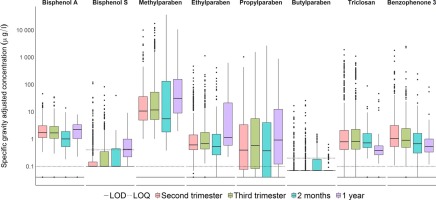当前位置:
X-MOL 学术
›
Environ. Int.
›
论文详情
Our official English website, www.x-mol.net, welcomes your
feedback! (Note: you will need to create a separate account there.)
Exposure to phenols during pregnancy and the first year of life in a new type of couple-child cohort relying on repeated urine biospecimens.
Environment International ( IF 10.3 ) Pub Date : 2020-04-02 , DOI: 10.1016/j.envint.2020.105678 Matthieu Rolland 1 , Sarah Lyon-Caen 1 , Amrit K Sakhi 2 , Isabelle Pin 3 , Azemira Sabaredzovic 2 , Cathrine Thomsen 2 , Rémy Slama 1 , Claire Philippat 1 ,
Environment International ( IF 10.3 ) Pub Date : 2020-04-02 , DOI: 10.1016/j.envint.2020.105678 Matthieu Rolland 1 , Sarah Lyon-Caen 1 , Amrit K Sakhi 2 , Isabelle Pin 3 , Azemira Sabaredzovic 2 , Cathrine Thomsen 2 , Rémy Slama 1 , Claire Philippat 1 ,
Affiliation

|
BACKGROUND
Parabens, bisphenol A and triclosan have been forbidden or restricted in specific types of consumer goods in Europe and France. Limited biomonitoring data are available in France since the implementation of these regulations, and exposure data on infants is scarce worldwide. Understanding the predictors of phenol urinary concentrations will help identify potential targets for prevention.
AIM
We described levels, variability and predictors of exposure to 12 phenols in pregnant women and infants recruited between 2014 and 2017 in a French couple-child cohort.
METHODS
Among 479 pregnant women and 150 of their infants, we studied phenol urinary concentrations in within-subject, within-period pools of repeated urine samples collected during the second and third trimesters of pregnancy (up to 42 samples per woman), at 2 months and 12 months (up to 14 samples per infant). Time trends and associations with demographic, protocol, occupational and behavioral factors were studied using interval censored models to accommodate for undetected and unquantified urine concentrations.
RESULTS
Detection rates were above 90% for bisphenol A, ethylparaben, methylparaben, benzophenone-3 and triclosan and below 5% for bisphenol AF, B, F and triclocarban. Median levels of bisphenol A, bisphenol S, methylparaben, ethylparaben and propylparaben at 12 months were similar or higher than during pregnancy. For pregnant women all phenols but benzophenone-3 and bisphenol S showed a linear decrease between 2014 and 2017 (p-values < 0.02). Women with the shortest education (primary and secondary school) had higher urinary concentrations of triclosan (β = 0.58 (95% confidence interval (CI), -0.04; 1.20)), ethyl (β = 0.43 (95%CI, 0.03; 0.84)) and propyl paraben (β = 1.39 (95%CI, 0.55; 2.24)) than those with the longest education. Cashiers had higher conccentrations of bisphenol S (β = 0.99 (95%CI, -0.11; 2.09)) but not of bisphenol A (β = -0.04 (95%CI, -0.26; 0.19)) than unemployed women.
CONCLUSIONS
Despite recent regulations, bisphenol A, triclosan and paraben detection rates were high in women and young infants. High bisphenol and paraben median levels at 12 months require further investigation as early infancy is a sensitive period for exposure to environmental contaminants.
中文翻译:

依赖重复尿液生物标本的新型一对夫妇队列在怀孕和生命的第一年中暴露于苯酚。
背景技术在欧洲和法国,在特定类型的消费品中禁止或限制了对羟基苯甲酸酯,双酚A和三氯生。自从实施这些法规以来,法国的生物监测数据有限,而且全世界婴儿的接触数据稀缺。了解苯酚尿液浓度的预测因素将有助于确定潜在的预防目标。目的我们描述了2014年至2017年在法国一对夫妇中招募的孕妇和婴儿中12种苯酚的暴露水平,变异性和预测因素。方法在479名孕妇及其150名婴儿中,我们研究了在妊娠中期和妊娠中期(每个妇女最多采集42个样本)的重复尿液样本在受试者内部,周期内的酚尿浓度,在2个月和12个月时(每个婴儿最多14个样本)。使用时间间隔审查模型研究了时间趋势以及与人口统计学,协议,职业和行为因素的关联,以适应未检测到和未量化的尿液浓度。结果双酚A,对羟基苯甲酸乙酯,对羟基苯甲酸甲酯,二苯甲酮3和三氯生的检出率均高于90%,而双酚AF,B,F和三氯卡班的检出率均低于5%。12个月时双酚A,双酚S,对羟基苯甲酸甲酯,对羟基苯甲酸乙酯和对羟基苯甲酸丙酯的中位数水平与怀孕期间相似或更高。对于孕妇,除了苯甲酮3和双酚S外,所有酚在2014年至2017年间呈线性下降(p值<0.02)。受教育时间最短的妇女(中小学)尿中三氯生的浓度较高(β= 0。58(95%置信区间(CI),-0.04; 1.20)),乙基(β= 0.43(95%CI,0.03; 0.84))和对羟基苯甲酸丙酯(β= 1.39(95%CI,0.55; 2.24))受过最长教育的人。出纳员的双酚S浓度(β= 0.99(95%CI,-0.11; 2.09))比失业妇女高(双酚A)(β= -0.04(95%CI,-0.26; 0.19))。结论尽管有最新法规,双酚A,三氯生和对羟基苯甲酸酯的检出率在妇女和幼儿中还是很高的。由于婴儿早期是暴露于环境污染物的敏感时期,因此在12个月时双酚和对羟基苯甲酸酯的中位数较高水平需要进一步研究。2.09)),而非失业妇女的双酚A(β= -0.04(95%CI,-0.26; 0.19))。结论尽管有最新规定,双酚A,三氯生和对羟基苯甲酸酯的检出率在女性和幼儿中还是很高的。由于婴儿早期是暴露于环境污染物的敏感时期,因此在12个月时双酚和对羟基苯甲酸酯的中位数较高水平需要进一步研究。2.09)),而非失业妇女的双酚A(β= -0.04(95%CI,-0.26; 0.19))。结论尽管有最新规定,双酚A,三氯生和对羟基苯甲酸酯的检出率在女性和幼儿中还是很高的。由于婴儿早期是暴露于环境污染物的敏感时期,因此在12个月时双酚和对羟基苯甲酸酯的中位数高水平需要进一步研究。
更新日期:2020-04-03
中文翻译:

依赖重复尿液生物标本的新型一对夫妇队列在怀孕和生命的第一年中暴露于苯酚。
背景技术在欧洲和法国,在特定类型的消费品中禁止或限制了对羟基苯甲酸酯,双酚A和三氯生。自从实施这些法规以来,法国的生物监测数据有限,而且全世界婴儿的接触数据稀缺。了解苯酚尿液浓度的预测因素将有助于确定潜在的预防目标。目的我们描述了2014年至2017年在法国一对夫妇中招募的孕妇和婴儿中12种苯酚的暴露水平,变异性和预测因素。方法在479名孕妇及其150名婴儿中,我们研究了在妊娠中期和妊娠中期(每个妇女最多采集42个样本)的重复尿液样本在受试者内部,周期内的酚尿浓度,在2个月和12个月时(每个婴儿最多14个样本)。使用时间间隔审查模型研究了时间趋势以及与人口统计学,协议,职业和行为因素的关联,以适应未检测到和未量化的尿液浓度。结果双酚A,对羟基苯甲酸乙酯,对羟基苯甲酸甲酯,二苯甲酮3和三氯生的检出率均高于90%,而双酚AF,B,F和三氯卡班的检出率均低于5%。12个月时双酚A,双酚S,对羟基苯甲酸甲酯,对羟基苯甲酸乙酯和对羟基苯甲酸丙酯的中位数水平与怀孕期间相似或更高。对于孕妇,除了苯甲酮3和双酚S外,所有酚在2014年至2017年间呈线性下降(p值<0.02)。受教育时间最短的妇女(中小学)尿中三氯生的浓度较高(β= 0。58(95%置信区间(CI),-0.04; 1.20)),乙基(β= 0.43(95%CI,0.03; 0.84))和对羟基苯甲酸丙酯(β= 1.39(95%CI,0.55; 2.24))受过最长教育的人。出纳员的双酚S浓度(β= 0.99(95%CI,-0.11; 2.09))比失业妇女高(双酚A)(β= -0.04(95%CI,-0.26; 0.19))。结论尽管有最新法规,双酚A,三氯生和对羟基苯甲酸酯的检出率在妇女和幼儿中还是很高的。由于婴儿早期是暴露于环境污染物的敏感时期,因此在12个月时双酚和对羟基苯甲酸酯的中位数较高水平需要进一步研究。2.09)),而非失业妇女的双酚A(β= -0.04(95%CI,-0.26; 0.19))。结论尽管有最新规定,双酚A,三氯生和对羟基苯甲酸酯的检出率在女性和幼儿中还是很高的。由于婴儿早期是暴露于环境污染物的敏感时期,因此在12个月时双酚和对羟基苯甲酸酯的中位数较高水平需要进一步研究。2.09)),而非失业妇女的双酚A(β= -0.04(95%CI,-0.26; 0.19))。结论尽管有最新规定,双酚A,三氯生和对羟基苯甲酸酯的检出率在女性和幼儿中还是很高的。由于婴儿早期是暴露于环境污染物的敏感时期,因此在12个月时双酚和对羟基苯甲酸酯的中位数高水平需要进一步研究。









































 京公网安备 11010802027423号
京公网安备 11010802027423号